

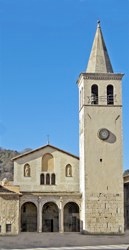
Campanile
The lower part of the campanile was built in the 12th century on a base made up of stone blocks from earlier buildings. The upper part dates to 1492.
Funerary inscription (11th century ?)
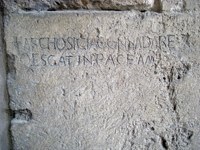
Façade
The facade originally reflected the high central nave and lower aisles of the interior. It assumed its present shape in ca. 1388, at which point the three niches were inserted above and to the sides of the original trifore window. Traces of frescoes (1413) of the Deeisis by Giovanni di Corraduccio survive in the central niche, although they are not visible from the ground.
The Renaissance portico was added built in 1515. The inscription (1788) reads:
VIRGO CONDIDIT - DECEM MILLIA MARTYRUM - CONSECRARUNT
A Virgin (St Abbondanza) built it; 10,000 martyrs consecrated it
Bishop Paolo Sanvitale rebuilt the central portal in 1597.
The facade was re-modeled in the 18th century, at which point the central trifore window was covered. Giuseppe Sordini reconstructed it from surviving fragments as part of the restoration of the facade in 1907.
Marble relief (8th or 9th century)

The sculpted relief , which may have come from the earlier church here, has been re-used as the architrave of the entrance to the left of the central portal. The left part of it is now missing: it originally depicted a peacock to each side of the central triangular motif of a cross flanked by a pair of lions.
SS Gregory and Barattalis (12th century)
These damaged stone statues are currently in the niches to the sides of the trifore window in the facade. They probably originally flanked the central portal and may have been removed from this position when the portal was replaced in 1597. They were recorded to the sides of the entrance to the Cappella degle Innocenti (see below) in the 19th century and moved to their current locations in 1932.
The figure of St Gregory is identified by inscription. The other figure is usually identified as St Barattalis: the church was consecrated in honour of both saints in 1146. However, some records refer to this second figure as St Abbondanza, and it is too damaged to ascertain which is the correct identity.
St Michael ( 14th century)
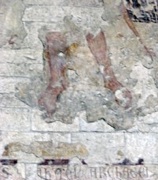
Cappella degli Innocenti (14th century)
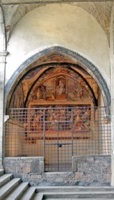
This chapel on the left, under the portico was first documented in 1415, when a legacy was made for its decoration. Its dedication must have been inspired by the memory of the discovery in 1254 of the bodies of abandoned babies in a well opposite the church: this discovery had prompted Bishop Bartolomeo Accoramboni to criticise the dereliction of the canons of San Gregorio Maggiore and to establish the nearby Ospedale della Stella (see Santa Maria della Stella).
No trace survives of the original decoration, which apparently included a fresco of the Crucifixion on the back wall.
The chapel was used as a baptistery for much of the 20th century.
Frescoes (ca. 1600)
The frescoes in the chapel depict:
-
✴the massacre of the innocents (on the lower part of the back wall); and
-
✴scenes from the life of St Abbondanza (the virgin).
The iconography of the scenes that relate to St Abbondanza reflects the life of the saint that Prior Decio Gelosi wrote in ca. 1597. This suggests that the frescoes were executed at about this time. They are sometimes attributed to Fabbio Angelucci da Mevale.
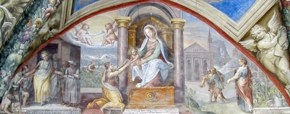
The fresco on the lunette of the back wall, which is particularly interesting, depicts:
-
✴St Abbondanza gives alms to the poor (on the left);
-
✴Madonna and Child with St Abbondanza (centre); and
-
✴St Abbondanza organises the burial of a martyr at San Gregorio (on the right), with a view of San Gregorio Maggiore and Ponte Sanguinario (see Walk II) in the background.
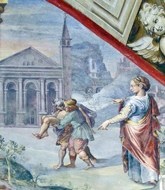
Apse
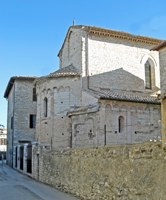
Canonica
A donation that Bishop Transarico made in 1178 to the canons of San Gregorio constitutes the earliest surviving documentation of:
-
✴a community of canons here, although it may well have been formed in ca. 1067, the date at which Bishop Andrea established or reformed the canonical community at the Duomo; and
-
✴an adjacent hospice.
In 1254, Bishop Bartolomeo Accoramboni discovered the bodies of a number of abandoned babies in a well opposite the church and criticised the canons for their dereliction in allowing their old hospice to fall into dilapidation. He established the Ospedale della Stella (see Santa Maria della Stella) on a nearby site, and the canons' hospice was probably closed soon after.
This hospice, which seems to have stood on the site to the left of the church, was later used for the canons' residence. Its central cloister has two orders of arches along three sides, the lower of which dates to the mid-14th century. The upper order seems to have been added in the 16th century.
There were ten canons in residence in 1266, but their number probably fell in the succeeding centuries. Their obligation to live in the canonica was removed in the 17th century and the canonica subsequently fell into disrepair.
A record of work carried out on it in 1794 relates to the "camera di San Pantaleone", which was presumably the room that housed the reliquary bust of St Pantaleon that is now in the Museo Diocesano.
Proceed to pages on: the interior; and the crypt.
Return to the home page on San Gregorio Maggiore.
Return to Monuments of Spoleto.
Return to Walk III.

